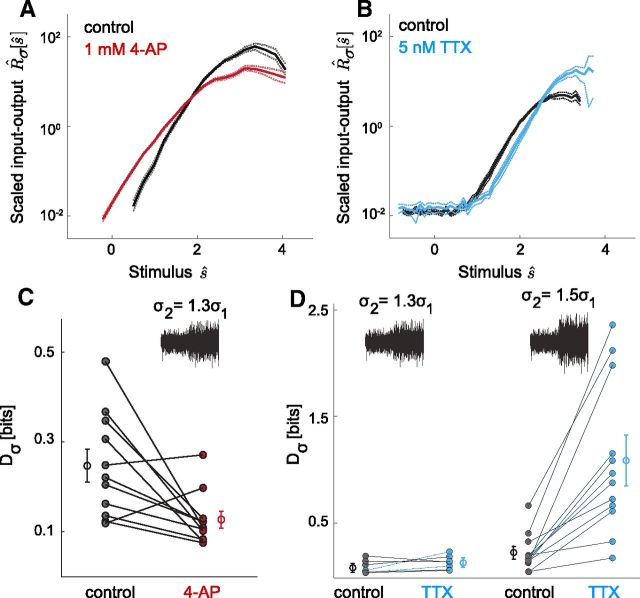Figure 5.
Two pharmacological manipulations of INa/IK change gain-scaling behavior in agreement with model results. A, B, Reduction of transient K-current changes input–output relation shape and improves gain scaling (organotypic slices). A, Mean R̂σ[ŝ] across neurons before (black) and after the addition of 1 mm 4-AP (red), n = 11. Dashed lines show ± SEM. B, Mean Dσ values before (black) and after addition of 4-AP (red). Lines show control and 4-AP pairings for individual neurons (control: 〈Dσ〉 = 0.27 ± 0.03 bits; 4-AP: 〈Dσ〉 = 0.16 ± 0.01 bits, n = 11). A majority of neurons showed an improvement in gain scaling (9 of 11 neurons, p = 0.014, paired t test, mean improvement of 35 ± 8%). Treatment with 4-AP resulted in a small increase in input–output relation similarity, DN (p = 0.013). C, D, Partial block of sodium channels shifts the input–output relation shape to higher stimulus values and decreases gain-scaling behavior (acute slices). C, Mean R̂σ[ŝ] across neurons before (black) and after the addition of 5 nm TTX (blue), n = 19. Dashed lines show ± SEM. Stimulus SD were changed by a factor Δσ = 100(σ2 − σ1)/σ1. D, Mean Dσ values before (black) and after addition of 5 nm TTX (blue) for 30% Δσ (left) and 50% Δσ (right) switches. Note change in abscissa scale from B. Lines show control and TTX pairings for individual neurons; 30% Δσ (n = 7) (control: 〈Dσ〉 = 0.08 ± 0.02 bits; TTX: 〈Dσ〉 = 0.13 ± 0.03 bits). A majority (5 of 7 neurons) showed an increase in gain-scaling error, but this difference was not statistically significant (p = 0.1773, paired t test; mean increase in error of 99 ± 52%); 50% Δσ (n = 12) (control: 〈Dσ〉 = 0.21 ± 0.05 bits; TTX: 〈Dσ〉 = 1.09 ± 0.21 bits). For this Δσ, all neurons showed an increase in gain-scaling error (p = 0.0004, paired t test; mean increase in error of 550 ± 150%). Error bars indicate SEM.

